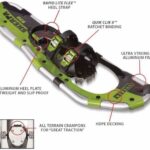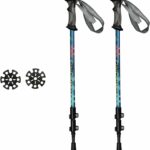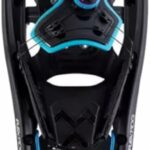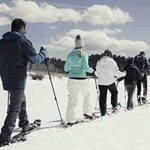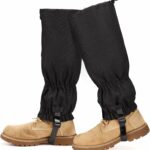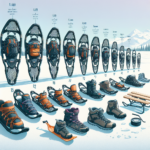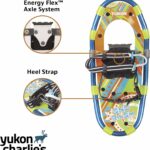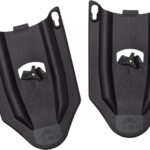Imagine you’re planning a winter hike and have got all your gear ready, but there’s one important thing left to figure out – how to properly size your snowshoes. You might consider this a tiny detail, but trust us, it’s one that can be the difference between an enjoyable snowy adventure or a frustrating slog. Finding the right snowshoe size is paramount, it directly impacts your walking comfort and stability in the snow. In this article, you are about to discover simple, practical tips to accurately size your snowshoes and ensure your winter explorations turn out to be smooth and comfortable.
Understanding the Importance of Properly Sized Snowshoes
In any sport or outdoor activity, it’s crucial that your gear fits you well, and snowshoeing is no exception.
Why Correct Size Matters
The correct size of your snowshoes matters for multiple reasons. The primary one is to give you optimal floatation. Floatation is the ability of the snowshoe to stay afloat in snow. When your snowshoes are correctly sized, they distribute your weight over a larger snow surface, preventing you from sinking too deeply into the snow.
Consequences of Wearing Ill-fitted Snowshoes
Wearing snowshoes of incorrect size can make you feel frustrated rather than exhilarated. If the snowshoes are too small for your weight, they will sink deeper into the snow, making it hard for you to move. If they’re too big, they may feel cumbersome and unwieldy, making your trip far more challenging than necessary.
Comfort and Performance Considerations
In addition to floatation, proper sizing impacts the comfort and performance of your snowshoeing excursion. Ill-fitted snowshoes can cause sore spots or blisters and reduce your overall performance by restricting your natural stride or causing unwanted strain.
Analyzing Various Types of Snowshoes
Snowshoes are not one-size-fits-all. There are different types, each designed for specific uses, terrain, and snow conditions.
Principles of Different Snowshoe Designs
Different snowshoe designs have different principles. Some focus on providing excellent traction for icy or steep conditions, while others maximize floatation for deep, powdery snow. Some are designed for the simplicity of trail walking, while others are intended for backcountry adventures full of trail-breaking and steep terrain.
Type of Snowshoes and User Suitability
There are generally three types of snowshoes: recreational, backcountry, and running. Recreational snowshoes are perfect for beginners and casual walkers. Backcountry snowshoes are more robust and rugged, suitable for uneven terrain or heavy loads. Running snowshoes are lightweight and streamlined, designed for speed and agility.
How Different Snowshoe Types Affect Sizing Considerations
The type of snowshoe influences sizing considerations. For instance, backcountry and running snowshoes tend to be smaller to allow more agility, while recreational snowshoes are bigger for more stability and floatation.
Examining Snowshoe Sizing Chart
A sizing chart is an essential tool to help you find your ideal snowshoe size.
Understanding the Snowshoe Size Chart
A snowshoe size chart aligns your weight with the appropriate size that can best support it. It’s also adjusted for the type of snowshoe and sometimes even considers the specific snow conditions.
Interpreting Variables on the Chart
The chart often has two main variables: user weight and snowshoe size. User weight should include not just your body weight, but also any gear or pack weight you’ll generally carry. Snowshoe size is usually expressed in inches and represents the length of the snowshoe.
How to Read and Apply Snowshoe Size Chart
Tto read the chart, first, find your total weight on the weight range. Follow that row or column across until you encounter the corresponding snowshoe size. This is your initial guide but remember, other factors can affect the final decision on size.
Measurement of Feet and Body Weight
There are two key measurements to know: the size of your feet and your total weight, including any gear or pack.
Why Foot Measurements Matter
While most snowshoes are one-size-fits-all when it comes to foot size, it’s good practice to try the binding with your winter boots to ensure they fit well and are comfortable on your feet.
Importance of Body Weight in Sizing Snowshoes
Your body weight greatly impacts snowshoe sizing. As mentioned before, heavier loads need larger snowshoes to provide adequate floatation.
Correct Way to Measure Feet and Body Weight
Use a regular measuring tape to measure your foot size. As for body weight, remember to include the weight of your usual winter clothing and any gear or load you plan on carrying during your snowshoeing trip.
Consideration of Snow Conditions
The state of the snow significantly affects your choice of snowshoe size.
Varieties of Snow Conditions
Snow conditions can vary from hard, packed snow to light, fluffy powder.
What Snow Conditions Mean for Snowshoe Size
Hard, packed snow requires less flotation and therefore smaller shoes. Light, powdery snow, on the other hand, might need bigger snowshoes to prevent you from sinking deep into the snow.
Importance of Assessing Actual Snow Conditions Before Snowshoe Sizing
It’s essential to consider the snow conditions where you will most often be using the snowshoes because different conditions require respective appropriate shoe sizes.
Terrain Factors in Snowshoe Sizing
The terrain where you’ll be using your snowshoes also impacts the size you should choose.
How Terrain Affects the Choice of Snowshoe Size
Flat terrains without a lot of obstacles might prefer larger snowshoes for better flotation. In contrast, hilly landscapes with lots of trees and obstacles might require smaller snowshoes for better maneuverability.
Different Terrains and Corresponding Snowshoe Sizes
Generally, flat terrains or trails use larger snowshoes, while rugged backcountry or mountainous terrains prefer smaller, more agile snowshoes.
Effect of Hilly Versus Flat Terrain on Snowshoe Sizing
Hilly terrains can make larger snowshoes seem clumsy and restrict freer movement. On the other hand, flat terrain might make smaller snowshoes sink more than necessary, making the walk less efficient.
Expected Activity Level and Duration
The intensity and duration of your anticipated snowshoeing activity affect the size of your snowshoes.
How Activity Level Affects Snowshoe Size
If you plan high-intensity activities or maneuvers that require agility, such as snowshoe running or navigating steep, icy terrains, smaller snowshoes can be more suitable.
Importance of Considering Duration of Use in Sizing
If you’re planning a long, leisurely walk, the comfort provided by well-fitted snowshoes becomes even more critical.
Balancing Comfort and Performance for Different Activity Levels and Durations
It’s necessary to balance comfort and performance when selecting the size. Neither should be compromised much as both are vital for an excellent snowshoeing experience.
Gender Considerations in Snowshoe Sizing
Snowshoes come in models specifically tailored for men, women, and even children.
Specifics of Women’s Versus Men’s Snowshoe Sizes
Women’s snowshoes are not merely smaller versions of men’s. They are designed to accommodate the typically shorter and narrower stride of women. Men’s snowshoes are intended for heavier loads and larger foot sizes.
Gender-tailored Features in Snowshoes
Female-specific snowshoes could have color variants, narrower frames, tapering tails, and bindings sized for women’s footwear. Male-specific shoes are sized and structured for larger and heavier loads.
How to Adjust Sizing Calculation by Gender
While the size chart gives you an initial guide, you should look for gender-specific snowshoes for most comfort and efficiency. Adjust the sizing based on gender-specific models available.
Tips for Trying on Snowshoes
Trying on snowshoes before buying is highly recommended.
Steps to Properly Try On Snowshoes
When trying on snowshoes, do so with the winter boots you’ll be using for snowshoeing. Step into the bindings and tighten them. Walk around to ensure they feel comfortable and manageable.
Signs of Well-fitted Snowshoes
Well-fitted snowshoes feel snug but not tight on your feet. They should align well with your boots, and the bindings should not pinch or cause hot spots.
Common Fitting Mistakes to Avoid
Avoid choosing snowshoes that are too large to handle or too small to provide enough flotation. Also, be sure not to fasten the bindings too tightly, causing discomfort.
Finalizing and Testing the Proper Snowshoe Size
After deciding on the size and model, it’s recommended to test your new snowshoes in the actual snow conditions and terrain you expect to encounter.
Importance of Testing in Actual Conditions
Testing in actual conditions allows you to ensure that you’ve selected the correct size and that the snowshoes perform to your expectations.
Correcting Issues After Trying Snowshoes
If you notice any issues such as poor flotation, restricted movement, or discomfort, you may need to reevaluate the size or model of your snowshoes.
Final Thoughts on Being Fully Satisfied with Snowshoe Sizing
Snowshoe sizing can seem complex, with many factors to consider. But taking the time to find the right size and fit for your needs will pay off greatly when you’re out enjoying the snowy landscapes with comfort and ease. Remember, the goal is an efficient, comfortable, and enjoyable snowshoeing experience. Now, you’re ready to find your perfect pair.
- What Snowboard Bindings Should I Get? - January 23, 2024
- What Size Screws For Snowboard Bindings? - January 23, 2024
- How To Snowmobile On Water? - January 23, 2024



